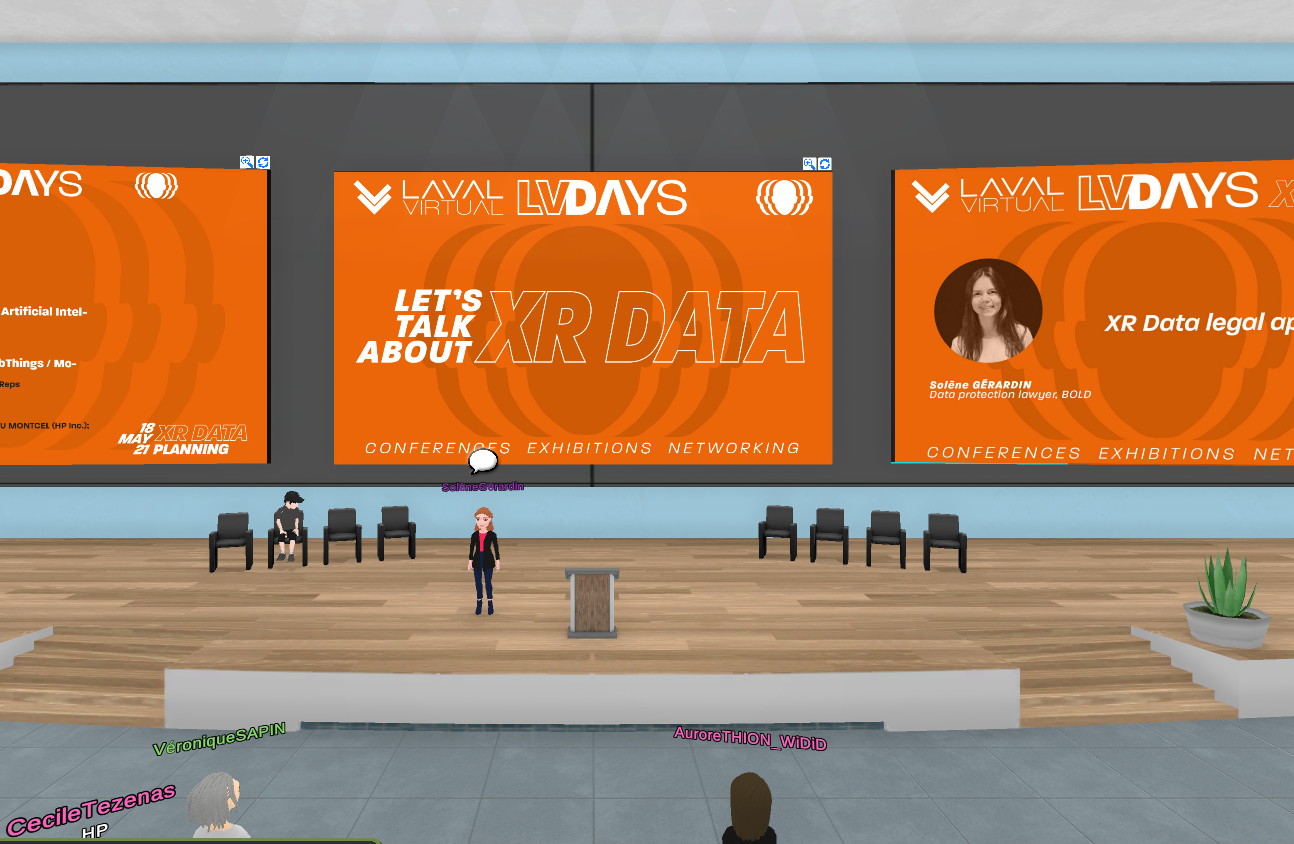
On 18 May, experts discussed the use of data in virtual reality.
Crédits photos : Grégory Maubon (Twitter)
On Tuesday 18 May, virtual reality experts gathered in the Laval Virtual World to discuss data and security. The Laval Virtual Days: XR Data put the issue of data protection back on the table. How is our personal data used? What are the regulations in force? What are companies allowed to do and not to do?
Protection, security, regulations: the challenges of good data use
How has virtual reality changed everything?
With the development of virtual reality, cutting-edge technologies and devices are massively arriving on the market. Always in search of more immersive and personalised experiences, XR creators are imagining ever more powerful tools. But this quest for personalisation inevitably leads to the collection of data. How and why?
Virtual reality headsets and equipment have changed the data landscape. This shift lies in the “sensitivity of the information collected” during an immersive experience: geolocation and biometric data, as Solène Gérardin, Data Protection Lawyer at BOLD, explains. Immersive technologies also rely heavily on facial expressions to operate their devices. However, all this information is considered personal data, and relates directly to the user’s privacy.
Data protection regulations in Europe
With the multiplication of actors collecting data, the security and reassurance of users is at stake. In Europe, the use of personal data is regulated by the GDPR: General Data Protection Regulation. Before its adoption by the European Parliament in 2016, “each country defined its own data protection laws“, recalls Solène Gérardin. One of the objectives of the GDPR was to remove all these national specificities and to harmonise the regulation.
The key article of the GDPR is Article 25 which talks about “privacy by default“. This is a principle according to which “when we develop a new solution, we must always integrate the principles of data protection. They must be applied automatically without having to ask the user,” explains Solène Gérardin. With regard to virtual reality and in particular biometric data, “it is forbidden to process and transfer them, unless the user’s consent is requested“.
The key point is that the user must be at the centre of concerns in terms of data protection. Philippe Coval, OpenSource Engineer, reminded us during his presentation that transparency and visibility must be prioritised, the privacy of the user must be respected and the focus must be on the user.
Data: the new Eldorado for XR creators?
A new way of advertising
But then, with all these regulations, how can we achieve a relevant use of data? Samuel Huber tried to answer this burning question. Three years ago, he founded his company Admix, which aims to create a new business model in the metaverse. His approach is to advertise in virtual worlds and especially in video game environments.
Advertisers are facing a new way of doing digital advertising. Ads and their relevance depend directly on data collected from users. Without this data, it is difficult to target the right audience. On the web, advertisers are able to track a user across all the platforms and sites they visit. Recently, users have the ability to personalise or even refuse cookies.
On the mobile side, Apple has completely changed the way advertisers work. In 2020, they announced a change to the IDFA: this is the “standard adopted by Apple allowing mobile advertising networks to track users and deliver targeted ads to them“. From now on, the user must give explicit consent for the advertiser to track them and collect data on their behaviour.
The web and mobile are becoming difficult environments to address, due to the regulation constraints. Where to find a new source to display ads in a relevant way? “Video games are a new media channel,” explains Samuel Huber. About 2 billion people play every day. “There are new signals that advertisers can gather about user engagement without knowing the player’s personal data.” This is a new source of revenue for advertisers but also for XR creators.

Video games are a new channel for advertising.
(Image source: Tech Crunch)
Designing better VR experiences with data
Beyond advertising, data is a goldmine for XR creators and solution providers. By capturing biometric data in particular, virtual reality experiences can be more immersive and personalised. Today, some VR headsets process user data in real time. This is the case with the HP Reverb G2, which captures heart rate, eye tracking and facial movements.
Cécile Tezenas du Montcel, VR Lead Europe at HP, explained how certain data are excellent indicators during an immersive experience. This is particularly the case for cognitive load: the amount of mental effort one has to put in to perform a task or learn something. “There is a link between cognitive load and performance or level of expertise.” This data is very interesting for measuring user engagement, brain capacity and content comprehension.
One of the best areas to take advantage of this cognitive load data collection is in training. For example, in soft skills training (conducting an interview, public speaking, cultural awareness), the VR headset can be used to measure the progress of learners. During high-risk training exercises (for the military, firefighters, police, etc.), the learner can have access to real-time information. For example, his or her heart rate is displayed on the screen: “it helps to try to calm down and manage stress.”
In conclusion, Cécile Tezenas du Montcel considers that “data is the next step in the future of virtual reality“. Data will be the next big evolution in the world of VR. On the one hand, the XR industry represents a potential environment for advertisers who need behavioural data. On the other hand, collecting data during a virtual reality experience allows for better results and analysis.

